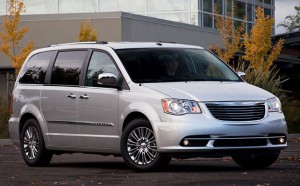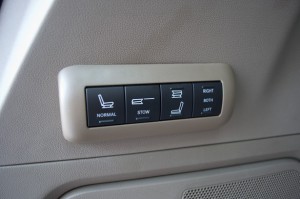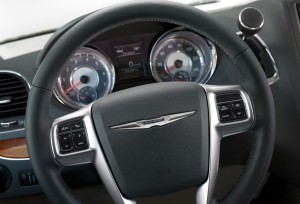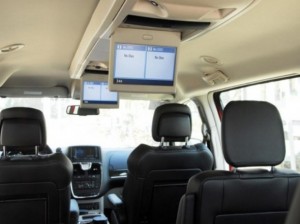It’s easier to shop minivans now than it was just a few years ago – because there are fewer minivans on the market. GM and Ford no longer sell them at all. And if you want a higher-end van, you’ve only got three models to dissect and compare: The Honda Odyssey, Toyota Sienna – and the Chrysler Town & Country, subject of this review.
The Chrysler’s got several things going for it – including a lower price all dolled up than its main rivals – still under $40k vs. over $40k for a top-of-the-line Toyota Sienna (and well over $40k for a top-of-the-line Honda Odyssey).
The Honda Odyssey Touring Elite, for example, is nearly $44k vs. just a little over $39k for a top-of-the-line T&C Limited. Chrysler also gives you a standard 283 hp V-6 vs. a standard 250 hp V-6 in the Honda – and a less-than-200 hp standard four in the base model Toyota Sienna.
On the other hand, the T&C is no longer offered with AWD. The Toyota Sienna is – and the T&C’s base price of almost $30k is a lot higher than the base price of a Sienna, which starts just over $25k.
So there are distinct pros – and cons.
Let’s take a longer look at both.
The T&C is Chrysler’s premium minivan, related to the Dodge Carvan but unlike its mass-market sister, the T&C comes decked to the nines with standard luxury features such as leather seats, music storage hard drive and rear seat entertainment system. That’s the base Touring model, which starts at $29,995. Go all the way to the Limited and your T&C will come with the entire kitchen, not just the sink: multi-screen rear seat entertainment system, heated first and second row seats, heated steering wheel, xenon HID headlights, an even better stereo and, if you want ’em, power folding/stowing third row seats. (The second row seats can be folded, too.)
This version of the T&C starts at $39,300. The Limited I tested – with pretty much every option on the roster – stickered out at $42,595.
Of the other lux vans out there, only Honda’s Odyssey (base price $28,375; $43,825 at the top) comes comparably equipped – and comparably priced. There’s also the Toyota Sienna – though it spans a wider range, with the base $25,060 version of that van being closer to the Dodge Caravan than the T&C. Base model Siennas are also equipped with a four-cylinder engine while the T&C (and Sienna) both come standard with pretty powerful V-6 engines.
Higher-trimmed versions of the Toyota are comparable on features – and price – but still lack the more upscale brand image that Chrysler has in its corner.
It’s already got everything. Plus more, if you want it.
Standard 283 hp V-6 is about 20-35 hp stronger than the standard (and optional) engines in Odyssey and Sienna.
Standard six-speed transmission (vs. five speed in the Odyssey).
Upscale cachet.
Plush ride.
Brilliant (and hugely useful) folding/stowing second and third-row seats. No need to remove anything to get a flat, load-ready cargo floor.
WHAT’S NOT SO GOOD
Despite its hp advantage, the T&C is a bit less quick than the V-6 Odyssey and Sienna.
AWD not available.
Guzzles gas almost as greedily as a V-8 SUV (17 city, 25 highway). They all do.
“Safety” aids such as park sensors err on the overcautious – and can be intrusive.
Every T&C comes standard with Chrysler’s new “Pentastar” 3.6 liter V-6, which delivers a very stout 283 hp. How stout? This is roughly 30 more hp than a V-8 powered Mustang Cobra delivered in the mid 1990s! It’s also 35 hp more than the Honda Odyssey’s standard 3.5 liter, 248 hp V-6 and 96 hp more the Toyota Sienna’s standard 2.7 liter, 187 hp four-cylinder engine. The Sienna can be upgraded with a 3.5 liter V-6, but its output – 266 hp – is still well below that of the T&C’s standard V-6.
But then, hp isn’t everything.
Despite its on-paper power advantage, the T&C is the least quick of these three minivans. It takes about 8.3-8.4 seconds to get to 60, which isn’t slow but is about half a second slower than the V-6 Odyssey and Sienna.
Those vans can reach 60 in 7.9 seconds.
Reason? The T&C weighs 4,652 lbs. vs. 4,337 for the Odyssey and a comparatively featherweight 4,275 lbs. for the Sienna – a difference of several hundred pounds.
With two adults on board, a T&C will be pushing – or exceeding – 5,000 lbs. That’s porky.
And it accounts for the T&C’s slightly more piggish EPA stats: 17 city, 25 highway vs. 19 city and 28 in the Odyssey (if you buy the optional six-speed automatic; five-speed versions come in at 18 city, 27 highway). The V-6 Sienna – which like the T&C comes standard with a six-speed automatic – rates 18 city, 25 highway.
These figures are not far off the numbers posted by some V-8 powered trucks and SUVs. For instance, the 2012 Ford F-150 with 5 liter V-8 rates 15 city, 21 highway.
Reason? “Mini” vans aren’t. Current models are large, heavy vehicles – in contrast to the originals, like the first Dodge Caravan, which actually were mini vans. A 1985 Dodge Caravan, for example, weighed about 1,000 lbs. less than the current T&C – and was about a third smaller overall.
Chrysler does provide an ECO mode to crutch things a little. Push the button – it’s on the center stack, below the AC controls – and the transmission will shift into the next gear sooner (and downshift later) and the torque converter clutch will engage sooner – and stay engaged longer. Engine idle speed will also be reduced slightly.
All together, it’s worth a couple of MPGs – if you drive as conservatively as possible.
One other thing to mention, powertrain-wise: Chrysler does not offer the T&C with AWD. The Honda Odyssey is also FWD-only. In fact, the only AWD-available traditional minivan you can still buy is the Toyota Sienna.
In which case, the MPGs dip to 17 city and 23 highway.
There’s a price for everything!
Having driven all three of the big-lux vans (the T&C, the Sienna and the Odyssey) I can relate to you the following:
The Odyssey is the most athletic – if you can say that about a not-so-mini van. The steering is slop-free, the ride is pretty firm and there’s very little body lean, for a minivan. The engine may not have quite as much power that the T&C’s V-6 does, but it sounds sweeter when revving higher – and because it’s not having to schlepp so much weight around, it feels lustier.
So, the Honda’s the track star of the bunch.
The Sienna, on the other hand, is the Queen Mary of the bunch. Serene and stately. Once the screws are turning and you’re out to “sea” – out on the highway – it is comfortable, quiet and smooth. But in the curves, its very soft suspension tuning gives it a wallowing, swaying sensation that’ll have your passengers reaching for the barf bags – unless you drive at, well, minivan speeds.
This is the van of choice for those not in a hurry.
And the T&C?
It is somewhere in between. Not quite as precise-feeling, on-center and true-tracking as the Odyssey, but more poised in the corners than the Sienna. In my opinion, the T&C is about “just right” – for a minivan. It’s got a nice mix of the Sienna’s ultra-plush ride and the not-too-mushy suspension/steering feel of the Odyssey. It’s great on the highway – and not too wallowy on curvy roads. You can drive it at a good clip without torturing your passengers. They will probably not even notice you’re driving a bit faster than the posted speed limit.
On acceleration: Despite being a step behind the Odyssey and Sienna in an all-out, pedal-to-the-floor drag race, the T&C moves out quite snappily. In fact, all three of these vans are only about a second less quick than cars that are considered quick – like, for instance, the Mazda Miata (about 7 seconds to 60). And thanks to long-legged overdrive gearing, these lunking, far-from-aerodynamic “mini” vans can trundle along for hours at 80 or more without any signs of straining.
Only two issues:
First, all these vans are entirely too fuel-thirsty. I averaged around 20 MPG during the week I had the T&C. Dismal. My 4WD truck does slightly better than that. The T&C is far too heavy – and so needs more engine than it ought to – and so burns more gas than it should. Ditto all the others – including the four-cylinder version of the Sienna, which does no better than the V-6 version of the Sienna.
One of the attractions of minivans used to be that they gave you the real-world versatility of an SUV, but without the obnoxious appetite of the typical big V-6/V-8 powered SUV. They still give you the versatility, but because they’ve gotten so heavy, their fuel usage is only slightly better than what you’d get in a current big V-6 or V-8 SUV.
And that’s just sad.
The T&C looks the part of a premium van – all trims. The chrome, the leather – all the power stuff.
The Odyssey looks expensive, too. But the base model Sienna just looks like a van.
Score one for Chrysler.
You also have to give it to Chrysler in what is perhaps the single most relevant minivan criteria: interior configurability and ease of use. The now-famous Stow n’ Go system lets you drop and fold the second and third row of seats, creating a flat cargo floor and almost 144 cubic feet of cargo room. My loaded T&C Limited had full power assist for the third row on top of that – but the point is you do not have to physically remove the seats to get the flat floor – as you do in competitor models. That is a job – even for a strong man. And once you’ve got the seats out. what do you do with them? Now they’re taking up space in your garage.
Chrysler’s system is magnificently clever – and brilliantly functional. Even if the rest of the van was mediocre, it would be a compelling selling point.
And the rest of the van is not mediocre.
As I already mentioned, the T&C starts out as a “dresser” – even the base Touring model is loaded with amenities (including leather and dual power sliding doors, power tailgate, power-adjustable pedals and rear seat DVD entertainment system). The base Sienna, on the other hand, starts out without many of these features and so looks – and is – a bit more spartan until you move up the food chain to the price/features-comparable version. But even then, it’s still a Toyota – which like Chevrolet is a bread-and-butter brand, not a higher-end brand. No offense to Toyota meant. The Chrysler’s just a little nicer, is all.
The Honda comes off as similarly smartset – and offers even more available “stuff” – such as a chilled beverage container, adaptive cruise control and a “multiview” perimeter-style camera system. But even though it has a bit more total theoretical cargo room (148.5 cubic feet) than the T&C, it’s more challenging to actually make use of it than it is in the Chrysler van. Same story with the Sienna – which has the most cargo capacity of the three at 150 cubic feet (and also the option of eight-passenger seating) but like the Honda, the Toyota lacks the T&C’s folding and stowing seats.
The Sienna does offer AWD, of course – which Chrysler used to but decided to drop. Probably because AWD would have pushed the T&C’s already-too-heavy curb weight even closer to 5,000 lbs. – and its EPA numbers even closer to V-8 SUV numbers.
Why hasn’t it occurred to anyone at the OEMs to make a diesel-powered minivan? A diesel engine would be the ideal powerplant for a minivan. They produce lots of low-end torque, just what a heavy (and not driven especially fast) minivan requires. High RPM hp is a wasted effort in a minivan. Imagine instead of 283 hp at 6,400 RPM – and a puny 260 ft.-lbs. of torque at 4,400 RPM – the T&C instead had 350-plus ft.-lbs of torque at a much more usable 1,500 RPM. This would give the van better off-the-line oomph than the thirsty gas engine – and probably 10 MPG better average fuel consumption, too. Just an idea… .
That aside, just a few additional points to make:
The T&C’s park sensors are hyper, hyper-conservative. Get within two feet of another car as you are trying to parallel park or back into a space and the (overly premature) warning dings commence. This is both distracting and annoying. If you’re a good driver, able to judge distances competently, this system will likely bug you, too. Worse, I was unable to locate an “off” switch … and nothing in the manual described any process for turning off the chimes and buzzers.
Second item: The shifter for the six-speed automatic is located, toggle-style, on the dashboard, to the right of the steering wheel. This is a solid idea. It saves space on the floor console and it’s more ergonomic – except for one thing. To work the transmission’s manual gear-change function, you have to drive one-handed. A paddle-shift arrangement on the steering wheel someplace would be better.
Great seat heaters – they actually heat as opposed to just getting slightly warm. Ditto the optionally available heated steering wheel.
Top drawer.
THE BOTTOM LINE
Unless you need AWD – or eight-passenger seating – the T&C will impress you with its mix of the practical and the luxurious.
Throw it in the Woods?
















Eric – Is the flat load floor level? I’ve seen several vehicles (such as the Ford Flex) where the seats fold flat, but they’re not level, so anything you carry would tend to slide to the rear of the vehicle.
Personally, I’m amazed that people spend $40k on a minivan. After all, they’re essentially disposable vehicles. You *know* the kids are going to destroy them, so what’s the point in buying anything fancy?
This may be reflected in their depreciated values…
Chip H.
Another market for minivans, in the coastal regions, is long boarders, or stand up paddle surfers. I have seen a last generation Sienna accommodate an 11 foot board, with the tailgate closed. Advantages over using roof racks include, better mpg, security, and stealth. With the rear seats removed or folded into the floor, you can comfortably sleep in them too, and dream about being the first surfer in the water for “dawn patrol,” (at least in your dreams.) Contrary to the minivan’s general image, in this niche they are viewed as “almost” cool.
I’d have one myself, if I still lived in “Surf City.” But Cali is a much better place “to visit” than “to live.” So I left. My surf wagon now is a short, class C motorhome.
Good review. We bought a 2011 T&C right after kid #4 was born (if I catch the bastard that keeps causing these damn kids…). Traded a Jeep Commander for it. My wife absolutely loves the thing and when she’s done with it, it gets handed down to me to use as a track wagon to haul the race bike around. The thing is uber-comfortable on road trips and with that stupid eco button dicking up the shift points, we actually see high 20s on the highway. All in all, it’s a great vehicle for a large family due to versatility and comfort.
To answer about diesel availability.
GasBuddy.com has a diesel option.
AM/PM and most ARCOs don’t have diesel, and I’ve never seen any at Shell. Costco doesn’t carry it either. I actually get B20 ‘biodiesel’ at Propel, there are several stations in the Sacramento area.
http://propelfuels.com/
Of course, since I’m talking about California brands, I can’t speak for other players like Sinclair or Sunoco.
I had a ’98 T&C LXi (it would now be the “Limited”) with a 3.8L OHV V6. This was before “Sto-n-Go”, but it had all-leather with four “Captain” chair seating. Part of me wishes that I’d hung onto it but at the time I gave up on it in 2008 (it DID have 163K miles, we bought it used at 58K miles in 2001 so we couldn’t complain) since it had a leaky transaxle (the infamous 41TE) and was beginning to slip. I understand that it went for about $30K when new, so accounting for REAL inflation, the current T&C is actually a decent deal. We paid $15K out the door and I got $3K for it, and beyond oil changes and two sets of brakes that I did myself (fairly easy even for ABS), it only bit me for a persistent electrical issue (common to the type) for $200. The 3.8L V6 was a bit doggy off the line but it cruised at 80 mph all day without seeming winded.
Eric, you won’t get any disagreement from me about a DIESEL. There’s just a few challenges for the Chrysler. Chrysler does have an impressive history with diesels, but most are big Cummin’s inline sixes, hardly suitable to a FWD minivan. They ARE using a V6 diesel made in Italy currently for the Jeep Grand Cherokee; it may be (1) contracted production rates, and (2) which diesels are allowed in CA? I’m not sure that European passenger car diesels (I’m read that diesel cars are about 60% of the consumer and almost all of the fleet market now in Europe since diesel is only a bit higher there than here, where as gasoline…) can be configured to CA Air Resources Board’s rather stringent standards for “low-sulfur” and “low-particulate” diesel emissions. The final problem would be: most women aren’t comfortable with an oil-burner. Even the more modern ones are noisy, temperamental, and sluggish compared to gas engines with comparable power. They require more driver attention. My guess is that if Chrysler starts offering a V6 (or Big Four or can they squeeze a Mercedes five-banger in a FWD mount?) in minivans, it’ll be fleet only at first (same with CNG).
To me, diesel is the way to go, unless you want a stripped-down econobox (but again, remember the “Wabbit” diesels, which even came in the pickup!) or a hot rod. It allows a decent-sized and crashworthy vehicle while at the same time delivering decent performance. If you are diligent about oil changes and servicing the fuel system and replacing the air filter, most diesels should deliver 300K miles of fairly trouble-free service. The only problem is, unless you become a diesel mechanic yourself, once the engine itself gets tired or (even MORE expensive), the injector pump quits, you gotta…THROW IT IN THE WOODS! Now, replacing injectors isn’t actually too difficult on most cars. Still, if you have ANY old Benz like I do, find a moonlighting mechanic. The MB dealerships make their mechanics sign an agreement that they won’t moonlight, but they really only get excited about “late” (less than TEN years), so, for something like my ’95 or even some of the eighties four and five-bangers (mostly 240D, 300D, and 300SD), it shouldn’t be hard to find a reliable mechanic that works for reasonable rates. As with anything, word of mouth, and, if you’re happy, recommend him to fellow oil-burner drivers. (S)He’ll appreciate the referrals and maybe cut your a deal on the expensive jobs!
In Europe, this is available *only* with a diesel. It is sold as the Lancia Voyager.
Hi Doug,
I was surprised to find out just how heavy these “mini” vans have become – almost 5,000 lbs. with driver on board! Given these are for the most part low-speed vehicles (and heavy low speed vehicles) a diesel engine would seem to be an ideal powerplant. So why hasn’t it been done? Probably because US diesel emissions regs. are fairly onerous and expensive to comply with. Europe is more diesel-friendly, which is why around half the vehicles on the roads over there are diesels.
Eric, I don’t think it’s the regs. At risk of sounding like a conspiracy nut, I think it’s the car manufacturers and oil companies that don’t want them here. They last longer, burn less fuel and typically don’t get replaced as often. Look at the numbers for the VW TDI models. The dealers can’t keep them on the lots. A few years ago, there was a Jeep Liberty with a light duty diesel in it that never stuck around on the lot long either. That model just disappeared. Dodge keeps teasing us with a diesel Ram 1500, but it’s never seen the light of day either. I know it would sell well. I’d buy one the day they hit the lots.
The passenger vehicle diesel is seen as a marketing failure. Why is it a marketing failure? GM’s attempt to make a gasoline Olds V8 into a diesel engine.
It is really that simple. People won’t buy them. People won’t buy them because of negative word of mouth based on a crappy implementation decades ago.
Yeah, that’s definitely a factor. My family had one of those miserable turds. 82 Cutlass diesel.
It is the regs, but not just the emissions ones. It is all the various legal barriers to entry for competitors. Of course there could be demand for better passenger diesels. But the major car manufacturers are protected from most upstart competition, so they have a bit of a captive market and can exploit that by refusing to offer them.
This is an interesting segment of the market and one that I have never seriously looked at.
It’s hard for me to consider the words “premium” and “minivan” in the same sentence, and I was stunned to find that there is such a thing as a $40k minivan. To me, $40k would actually buy a pretty nice car or truck. To spend that kind of money on a minivan seems backwards to me, much like spending $40k on an economy car (I’m looking at you, Chevy Volt).
Of course, I have some good friends whose “dream car” was always a Chrysler T&C and they got one shortly after they got married (it’s now about 10 years old) even though they didn’t have their first kid until 2 years ago. Different strokes for different folks, I suppose. This is one of those times I do not envy you your job of being an automotive journalist. I would much rather, personally, be driving an ultra-compact $8k car than any minivan sold today, even if it is a $40k luxo-cruiser (again, hard for me to imagine).
Incidentally, I was surprised at your comment regarding Toyota vs. Chrysler, “But even then, it’s still a Toyota – which like Chevrolet is a bread-and-butter brand, not a higher-end brand. No offense to Toyota meant. The Chrysler’s just a little nicer, is all.” It might be a generational thing, but I consider Toyota at least on par with, if not more upscale than Chrysler. To me, not being of the generation of the Chrysler Imperial or what not, I don’t think of Chrysler as any more upmarket than Chevrolet. I think cheap plastics, fake wood trim, wannabe Oldsmobile/Buick. I think PT Cruiser, Cirrus, Sebring, etc. The most luxurious Chrysler I can think of is the recent 300 and they really don’t seem to be much to write home about. Granted, Toyota had pretty humble beginnings, but I think my generation and younger can easily think of Land Cruisers, Sequoias, Avalon, etc. as being much higher end than anything that Chrysler has put out in the past 20 years. It’s not that Toyota always is higher end, just that they are broader in range. And don’t even start on Lexus.
That may explain the fact that the Sienna has a broader range of options and prices, since I’m in the target demographic range (most of my friends are young married couples with kids) and I would, judging from brand and perception of luxury alone, would much rather drive a Toyota than a Chrysler. This may speak to the poor marketing done by Chrysler among its subunits (Dodge, Jeep, etc.) than anything else, especially reality.
I had never considered a diesel minivan, but you’re absolutely right. I have a question for you, though, Eric, and anyone else who regularly drives diesel vehicles. How hard is it to find convenient diesel fuel stations in a practical sense. If you’re running low on diesel, can you generally count on the fact that you can pull into any given station and have at least one diesel pump on hand, or do you often find that you have to drive through a few stations or just really hope they post their diesel prices on the big sign on the corner (some do not do so even if they have diesel, I’ve noticed). Having never owned a diesel (to my shame), I have no sense of if this is really any sort of a hurdle or minor annoyance. I get the sense that you used to pretty much count on truck stops being your bread and butter, but today they seem to be more common.
These things – $40k minivans – are essentially downscaled, high-end RVs. The original minivans were much more utilitarian – built for families with kids. Kids who were going to make a mess. But a market emerged for a van with all the luxury amenities, intended for adults. The T&C is a case in point. You would not want to put three or four screeching pre-teens in this one! They’d make short work of the nice leather seats and electronics.
On diesel: My experience has been that it depends where you happen to be. In my area, every station, just about, sells diesel. But that’s because I live in a rural area; lots of big trucks and farm equipment, etc.
On the other hand, the diesel’s usually much greater range makes this less of an issue. If you can 500-600 miles on a tank, you should be able to locate a filling station that sells diesel before you run dry!
I drive a 2008 Mercedes Diesel M-Class (a fabulous car by the way). Live in the middle of the city of Houston. Diesel is almost everywhere.
Sometimes I have to pass a few stations, but very quickly you (1) remember where good diesel stations are, and (2) never panic, because you fill up a lot less often and are almost never down to the very last fume when ready to fill up.
The only piece of advice I have is that all diesel is not created equal. Depending on the station, I see variances of 5-10% in fuel economy.
Re: Diesel
If traveling by the interstate system (or anywhere else with regular truck traffic) finding diesel is not difficult.
In the metro area Washington D.C./Baltimore/Phl/NYC/Boston there are enough stations selling diesel that you can get fuel when needed.
I do not recommend running the tank empty since that may cause problems restarting. (IIRC, it has something to do with an empty fuel line.
$40,000 is pricey for a minivan, IMO. I would think 20-25k to be more reasonable.
I should have specified that we bought a *2012* Sedona.
I drove all of the available new minivans when it came time to replace our 2003 Kia Sedona. I looked at the T&C, the GC, the Sienna, and the Odyssey.
The Kia scored the most points on my balance sheet, and we bought one in January of this year.
I’m wondering why there was no mention of the Sedona in the above review. Yes, I see the part about “premium” minivans, but I don’t really understand why the Sedona isn’t considered one.
A few things stood out on the Sedona.
1) Price. We scored our new Sedona for a little over $21k.
2) Power. This van is a growler. You can light the tires with little effort. At 271 horsepower in the standard trim, it’s near the top as far as power is concerned; but more important is the delivery. The gearing is perfect. Once you mash the gas, you’re going to leave the area in a hurry. If Kia were to offer this powertrain in a small, lightweight body, they would have a reliable, world-class supercar — which they could sell cheap.
I think Kia would do well to offer a “sport sound” tuned exhaust.
As far as quibbles, there are a few things Kia did wrong:
1) They reduced the front legroom by shortening the seat adjustment tracks. It’s fine for the sub-6-footer, but those of us taller than that will find the front legroom to be badly cramped.
2) Given how overpowered this van is, when flogging it is not desired and fuel economy is preferred, the “Eco” settings should significantly dial down throttle response and perhaps turn off some cylinders.
3) There should be a place to install subwoofers, and have a set as options.
4) Visibility has suffered. The seat headrests impede it, as does the shape and size of the windows. Our old 2003 was better.
Hi Marc,
The only reason the Sedona wasn’t referenced in the review is just what you’ve guessed – it’s not considered a premium van. I know, I know… and I agree: Objectively – in terms of features and so on, it is certainly comparable. If I were minivan shopping, I’d look at the Sedona, too – and might even end up buying it. I am – and have been – very impressed with Kia’s (and Hyundai’s) products. They really are a great value.
As they have grown in size, today’s “mini”vans have come to almost fill the market niche that used to be held by the old full sized vans. And they have created a void in the segment they used to occupy. It would be nice to have minivans available in the same size as Chrysler’s original.
Unfortunately, almost every manufacturer has chosen to fill that segment (as well as the station wagon void,) with a total glut of CUVs. Maybe they know what they’re doing. But I doubt it.
I agree. The closest to it – the old-style “mini” vans – is (was) the Mazda CX5.
My theory is that increasingly powerless-feeling Americans gravitate toward bigger and bigger vehicles as a compensatory measure.
I think it’s probably just that Americans keep getting fatter.
“I think it’s probably just that Americans keep getting fatter.”
That’s certainly an issue. But it’s a lifestyle issue. A personal choice. Exactly like not changing your oil because you’re too lazy or cheap.
Then expecting “society” to buy you a new engine. Or gibs you heaf cayhuh.